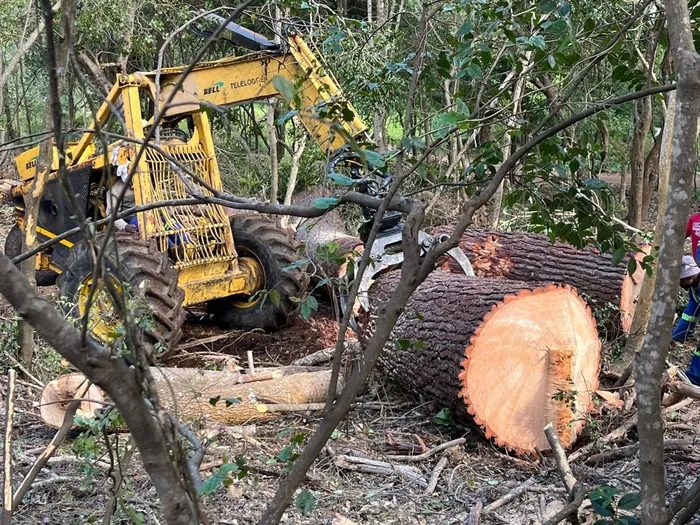Greenbelt cleared five months after illegal felling

A logger is being used to clear a section of the Klassenbosch Greenbelt where illegal felling happening earlier this year. Picture: Supplied
The City says it has claimed compensation for damages caused by the illegal felling of trees on a Constantia Valley greenbelt in April.
The trimming and felling of trees on Jerome Cedras’s Spilhaus Avenue property and an adjoining strip of the Klaasenbosch Greenbelt to “improve the view” sparked public outrage (“Greenbelt tree felling draws outrage,” Bulletin, May 2).
At the time, Mr Cedras, said the clearing on his property had been lawful and he blamed his contractor for the “very unfortunate incident” in which pine trees had been felled and pruned on the municipal greenbelt land next to his property. Meanwhile, mayoral committee member for community services and health Patricia van der Ross said the City had earlier turned down Mr Cedras’s request to remove the large pine trees on the City land to improve his view as the trees had been deemed healthy and posed no risk to the property.
Now, five months later, Ms Van der Ross said the recreation and parks department had completed an investigation and was in the final stages of concluding the matter while a contractor had started clean-up operations on Monday September 2.
“Cost claims for the damages were successfully implemented against the transgressor’s municipal account, and Law Enforcement is finalising details to coordinate legal action,” she said.
Asked how much compensation had been paid, Ms Van der Ross said it was “sufficient to cover the costs of repairing and re-instatement of the greenbelt” but we would have to submit an application through the Promotion of Access to Information Act for information related to the fine and who it was served on.
However, Mr Cedras told the Bulletin that he had borne the liability for “clearing the collateral damage” and undertaken to plant a “specified amount of indigenous trees on the site”.
“We are pleased to advise that the costs in respect of the above have been settled, and the restorative work on the greenbelt is under way,” he said.
Mr Cedras said it had been established that the trees had been “inadvertently removed by the privately appointed tree-felling contractor, who failed to carry out instructions given to him by both the developer, as well a City official, prior to this unfortunate incident taking place”.
Colin Walker, the founder of Friends of Constantia Valley Greenbelt, said the undergrowth and small trees would have been smothered under the “mess” left behind by the illegal felling and suffered permanent, extensive damage.
“This will inevitably result in much more longer term rehabilitation work (and cost) than would otherwise be necessary,” he said.
The Bulletin has received pictures showing a logger machine being used to clear the site.
Mr Walker said the City’s clean-up operation was only aggravating the damage caused by the initial illegal felling on 10 000m² of indigenous forest with a lot of saplings.
Damage would have been minimised had it been cleaned up relatively quickly and sensitively; now replanting the whole area might be required to offset the damage done, he said.
According to Mr Walker, small, younger trees will take 10 years to get to a screening stage, and replanting 30 indigenous mature trees to cover the area could cost about R200 000. Without any action, the area would look bare with an open view to the property from the greenbelt for years. To deter similar activities of illegal felling, he said, justice had to be seen to be done.
The incident was an example of how Constantia's semi-rural character and green heritage was being lost due to the City’s densification policies, he said.
“The City’s lax application of various municipal planning by-laws pertaining to densification is significantly contributing to the progressive reduction of the urban forest in this sensitive region. The biggest contributor here is the approval of subdivisions below minimum standard plot sizes as stated in the Municipal Planning By-law, sometimes allowing subdivisions to as little as 20% of the stipulated minimum plot size."
The friends group is challenging proposed changes to the Municipal Planning By-law, which the City says will streamline development processes (“City proposes changes to planning by-law,” Bulletin, August 1).
“These City proposed amendments will significantly enhance the City’s powers to ignore objections to inappropriate densification and approve departures from zoning restrictions, minimum erf sizes etc. In fact, with the proposed amendments all that will be required to develop, will be for building plans to be submitted for approval with the other current restrictive requirements, in effect, being scrapped altogether.”
The organisation is working with other civic groups to tackle the City on what it feels is inappropriate densification and to preserve the suburb’s green heritage, and it is asking residents to get involved.
Mayoral committee member for spatial planning and environment Eddie Andrews said the City’s development management department was guided by policies for an area and had to follow the Municipal Planning By-law when considering applications,
“All applications are circulated to the respective City departments who then comment on the plans after considering the nature thereof. Development Management then incorporates those inputs before the plans proceed to a decision maker,” he said.


Related Topics: